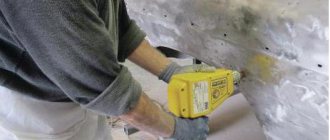Troubleshooting
When the microwave turns on, but for some reason does not heat the food, this may be due to a malfunction in the high-voltage circuit or magnetron.
But before checking these elements, it is necessary to carefully examine the working chamber itself. It should not contain any dirt, burnt holes, or worn out enamel. In the left wall of the chamber there is a special window, covered with a plate of transparent dielectric. This plate must be removed and carefully examined. First, the plate should be cleaned of contaminants with alcohol, and then make sure that there are no through burnt holes or darkening from exposure to electrical discharges. Otherwise, the plate must be replaced. In addition, such defects indicate that the microwave was started without a load or with metal objects inside the chamber.
The magnetron is one of the main elements of a microwave oven. It is a very powerful lamp that generates electromagnetic waves of a certain frequency. There are a number of very important elements in the high-voltage magnetron circuit. This is a transformer, a high-voltage diode and a capacitor, a safety diode, which burns out in the event of an emergency.
The safety diode is located near the transformer in a special container.
Its condition can be easily determined by its appearance. A burnt-out element must be replaced with exactly the same one with similar indicators.
The high-voltage transformer is checked only with the load and primary winding disconnected. To disconnect the transformer, you need to remove the terminals with pliers. The primary winding should have a resistance of about 1.5 Ohms, the secondary - 110-120 Ohms, and the secondary filament winding - less than 0.1 Ohms. If none of the windings ring, then the transformer must be replaced.
The magnetron is connected to the transformer using a connector. After disconnecting the terminal, you should check the resistance between the housing and the terminals. If there is no resistance, this means that the feed-through capacitors in the filter are broken. In this case, you need to change either the capacitors or the filter itself.
By removing the magnetron from its regular place, you can check the condition of the antenna cap. If the cap is damaged, it should be replaced. At the same time, you can check the condition of the magnetron insulator. If there are breakdowns in the housing or antenna, they must be replaced, but if the microwave has been in use for quite a long time, this may not be economically profitable.
If the microwave still does not work after all the measures taken, then you should check the locking system. First, check the tightness of the oven door and the reliability of its locking. To do this, use a sheet of writing paper. When the door is closed, the sheet of paper should be pressed along its entire perimeter so that it cannot be pulled out.
If, when the door is closed, a sheet of paper can be slipped under it, then the door requires adjustment. Adjustment is made from the side of the lock and hinges. It is necessary to achieve a tight and complete fit. Otherwise, microwave radiation will extend beyond the working chamber.
The microswitches should also be checked. They are called by the tester in closed and open states. If at least one is faulty, all of them must be replaced, since they all have approximately the same wear. If, when checking the high-voltage part and power circuit of the microwave oven, no faults are identified, the control unit should be diagnosed.
Useful tips
Finally, a few simple tips for using microwave ovens that will save you:
- everyone knows that the surface of a microwave oven is flat, but this is not a reason to use it as a stand;
- do not use extension cords when connecting the oven to the network;
- do not turn on the device unless the door is closed;
- leave a little space between the wall and the microwave oven for better ventilation;
- use dishes without metal patterns;
- It is not advisable to heat products containing alcohol in the microwave;
- Make holes (for example, with a fork) in products with skins.
Cause of microwave oven failure
The design of MVPs from different manufacturers is practically the same. Korean LG, Samsung, Daewoo, Japanese Panasonic, Supra, Sharp or the British brand Scarlett ") have a similar device. They differ only in small nuances: design, color, control panel, number of bolts. Therefore, our article is suitable for diagnosing and repairing any microwave oven. The food in the oven is heated by electromagnetic radiation generated by a magnetron. Therefore, it is logical to assume that if the stove does not heat, it is the culprit. But since the operation of the magnetron depends on many other parts and systems, you will have to check them too.
The microwave has stopped heating or is taking a long time to heat - what’s the problem?
- The network voltage is less than 220 W. A slight voltage drop may not be noticeable from the outside. The appliance, as usual, rotates the tray, lights up, but does not heat the food well or does not heat the food at all. If your assistant heats up every once in a while, the reason may lie in unstable voltage. Check the voltage in the outlet with a tester.
A reading below 220 W indicates an unbalanced, overloaded network or poor-quality transmission line; problems at the substation are also possible. Network unloading will eliminate this problem - do not turn on many powerful devices at the same time. Install an uninterruptible power supply. If the measures taken do not help stabilize the voltage, contact your electricity supplier: the problem may be a damaged power line.
- Magnetron malfunction.
A malfunction of the magnetron is indicated by sounds atypical for MVP. The device makes noise, hums, buzzes louder than usual, but does not heat well or does not perform the heating function at all. Check the inner walls of the oven - the presence of carbon deposits is a sign that this part has broken. A broken magnetron cannot be detected by a multimeter; it can be replaced by carefully following safety rules.
- The door lock is broken.
If there is no blocking, the heating process will not start. So the developers made sure that microwaves do not harm you through the open door of the device. If the oven is not working, check the shutter mechanism and door hinges. This minor damage is easily fixed by replacement.
- The fuses (or one of them) have blown.
If the microwave begins to heat worse, but the tray is spinning, check the fuses. To get to the fuse, you will have to disassemble the housing. A burnt-out one differs from a serviceable one by the presence of carbon deposits on the glass bulb and a broken spring.
- The capacitor and diode have failed. If the capacitor breaks down, the microwave beeps, heats up weakly, and the ohmmeter needle remains motionless when the signal is dialed. A diode failure causes increased buzzing during the process, and the oven heats poorly. The capacitor and diode must be replaced, and in some cases repaired (for experienced craftsmen).
- The control panel is broken.
It happens that the buttons “stick”, the contacts come loose, and the microwave does not turn on. Try disassembling the control panel, checking the contacts, cleaning the keyboard.
Some of these breakdowns are easy to fix on your own; in difficult cases, you will need the help of a specialist or even purchasing a new microwave.
Do-it-yourself repairs require certain skills and compliance with safety precautions:
- Always unplug equipment before making repairs.
- Always wear special dielectric gloves.
- Use tools with insulated handles.
- Do not operate a disassembled, damaged, open or empty microwave.
- Discharge the capacitor before repairing. For example, use a screwdriver on the housing (up to 1000 volts) or connect the capacitor contacts with pliers if the power is above 1000.
- Do not leave metal objects or tools inside the oven.
- Do not make holes in the housing.
What to do if the MVP heats the dishes and not the food
If your assistant heats the plate itself instead of the contents, you most likely chose the wrong cookware. Microwave dishes should not contain metal, many water molecules, non-heat-resistant plastic, or melanin. These materials interact with electromagnetic waves, heat up, melt, and shiny metal objects reflect particles, creating an electric arc that can cause a fire or short circuit. Therefore, purchase special heat-resistant dishes marked for microwave use.
We have listed the main reasons for such a problem as lack of heating in the microwave. Remember safety precautions. We wish you a successful and easy repair!
Bad 2
Interesting
Super 1
Operating rules
We have told you about the main malfunctions and some ways to eliminate them, but it is much more important to prevent various problems from occurring. To prevent them from happening, follow strictly simple recommendations:
- Never use metal utensils to heat food (the list of permitted ones is presented in the article what utensils to choose for a microwave oven).
- You cannot turn on a microwave without food in the working chamber (for more details, see the article on what will happen if you turn on an empty microwave and whether this can be done).
- Heat liquids and fry eggs only in closed containers.
- Preventive maintenance should be carried out regularly; all parts with extreme wear must be replaced in a timely manner.
- Keep the camera and platform clean.
- To eliminate the influence of power surges in the network on the uninterrupted operation of the product, a special power supply is installed.
Every user should know that a microwave oven is a very complex, dangerous high-tech product that must be handled very carefully, comply with all manufacturer requirements and follow operating instructions. Taking good care of any household appliance significantly extends its intended service life, so microwave devices will delight you with high-quality work, and not with frequent and burdensome repairs.
Design features
When diagnosing the condition of a microwave oven and planning to repair or replace individual components, you need to take into account the design features of the equipment. Each manufacturer, when creating equipment, adheres to different technologies and uses individual components, so repairing a microwave oven is only possible if you have certain knowledge.
LG
Modern microwave ovens from LG have L-Wawe technology, thanks to which the generated waves propagate in a spiral manner and ensure more uniform and deep penetration of heat into all parts of the dish. The special design of the inner surface of the housing allows the waves to be distributed throughout the chamber.
Samsung
The main distinguishing feature of Samsung technology is the coating of the camera with bio-ceramics. This material is completely safe for human health, is easy to clean from contamination and has increased resistance to damage. Due to the low thermal conductivity of bio-ceramics, heat losses are reduced and the process of cooking and heating food is accelerated.
"Bork"
New models of microwave ovens provide many programs that allow you to defrost food, perform quick heating, and cook food in different modes. A more complex control system often creates problems when trying to repair equipment yourself. When faced with a malfunction of the electronic components of the Bork microwave oven, you should seek help from specialists.
Daewoo
Microwave oven manufacturer Daewoo has one of the leading positions in the market due to the production of equipment with intuitive controls and affordable prices. One of the specific models is an oven with an additional compartment for cooking pizza and pancakes. In this variety you can cook 2 dishes at the same time. The disadvantage is the complex internal structure, which makes repairs and replacement of components more expensive.
"Sharp"
produces stoves with a basic configuration that do not have any special distinctive characteristics. Modern varieties are equipped with touch screens and displays.
Panasonic
Microwave ovens of the Panasonic brand are distinguished by many additional programs for cooking and heating food. A complexly designed control system requires professional repair if an electronic component breaks down.
"Elenberg"
Products are built with a basic internal configuration that allows for easy component repair. If more modern versions with a touch panel break down, you should contact a service center.
How does a microwave oven work?
First, let's explain the principle of its operation. The basis of the machine is a magnetron, which creates an electric field. It acts on the liquid molecules in the product. They start to move. When they rub against each other, heat is generated. Due to this, as well as the use of additional devices, the equipment performs many functions - heating, defrosting, grilling and others.
Why does the microwave not heat up and makes a loud noise?
Have you encountered the following: the microwave has started to make a loud noise when operating, your food is not heating?
Then you should understand the following reasons:
- the diode broke. The current moves in one direction and in the other, its path is closed. In such cases, the microwave will hum;
- The capacitors are dry. A large number of waves are collected, which generate these sounds;
- The magnetron is broken. Its malfunction provokes the creation of a strong sound.
Remember that if you unplug the microwave, it still contains a charge in the capacitors, which means it can shock you with a current of up to 5,000 V. Work should only be done with instructions and protective tools.
Mica and waveguide contamination
It is difficult not to notice such a malfunction, since something in the microwave sparks and crackles, but it works. Microwave energy is spent on heating fat and pieces of food that fall on the mica plate and inside the waveguide, as well as creating light and noise effects. Therefore, trying to heat food to the required temperature will not be successful. The problem can be resolved by thoroughly cleaning the pad and waveguide. In case of severe damage, up to the appearance of burnt holes, the plate is replaced. Mica blanks for overlays are sold in radio stores.
What to do if the microwave stops heating?
There are times when a microwave that has been in service for so long seems to be working, but the food is cold, and you have to resort to old methods of heating. There are many reasons for this problem. This article will discuss these reasons and options for correcting them.
Main causes of failure
If the microwave runs for 3-4 minutes and the food is still cold, there is a problem with the operation of the device.
The main reasons for this failure:
- It is necessary to check the correctness of the set mode. For example, “defrost” cannot serve as a reheating function.
- Voltage fluctuations. This leads to problems with the operation of the oven.
- The door is not tightly closed. Broken lock or latches.
- The mains or high voltage fuse has blown.
- The high voltage diode and capacitor are damaged.
- Faulty feed-through capacitor.
- Failure of the magnetron and electromagnetic lamp.
The main guarantee of long-term microwave performance is careful handling of equipment. Do not place metal bowls, cups, or heat them in foil or dishes with shiny rims. Stained walls need to be washed well and in a timely manner. If there are frequent voltage drops in the room where the microwave is installed, install a regulator and stabilizer.
Fixing a simple breakdown yourself
The main causes of inoperability can be eliminated yourself, while saving a decent amount on repairs at service centers. A little patience and attentiveness combined with desire and that’s it - the problem is solved.
Minor breakdowns and their solutions:
- Wrong mode. According to the instructions, set the mode and place the dishes with water in the oven for a couple of minutes. The wrong function may have been installed.
- Low voltage. You need to plug the stove into a power outlet; if there are other devices powered from the same source, turn it off.
- Door damage. When closed, the latches trigger the magnetron. To fix it, replace the lock and check the microwave.
If these actions still do not help, the breakdown is much more serious and other methods are needed.
Elimination of serious breakdowns
As mentioned earlier, there are several options for failure. You can solve them in the following way.
If the cause is the fuse:
- unscrew the rear casing (put the screws in a box so as not to get lost);
- remove the faulty part and replace it with a new one (they differ in color, shape deformation, if they do not differ visually, you need to check the resistance to identify the unusable element).
The reason is the multiplier:
- use an ohmmeter to check the resistance (weak - indicates a breakdown, and if the deviation is small - everything is in order and the reason is different);
- you also need to check the diode;
- replace the part with a new one (repairing a damaged one will cost more).
EM lamp feed-through capacitors:
- check resistance;
- If, when checking the transformer, the voltage is below 220 W, the part has failed and needs to be replaced with a new one.
Magnetron or magnetron lamp (one of the main reasons when the working oven does not heat):
- here the main problem is the inoperability of the filament;
- you can try changing the resistance to clarify the problem;
- The ideal option is to replace the entire part, since after a while, after repairing the thread, the problem will appear again.
General Tips
If you discover a serious breakdown, you need to remember a few rules to fix it yourself:
- Before undertaking DIY repairs, carefully study the instructions and diagram of the device.
- When troubleshooting, disconnect the device from the power supply.
- You need to buy parts according to the model in specialized stores.
- After installation, check the device for functionality. The back cover must be closed while the oven is operating.
Also, you should not expect reliable and long-term operation from cheap equipment. Such devices are designed for a short service life, and spare parts for them are quite difficult to find. The cost of purchasing a microwave oven from a well-known brand is slightly higher. But they guarantee many years of reliable use, and if they break down, you can easily find the part you need.
In conclusion, it is worth noting that the above are the main reasons when a working microwave does not heat. Always remember, before you run to the service center, you should carefully read the instructions and check simple problems. This will help save the family budget from unnecessary expenses.
Preventing damage
We have shared with you information on what to do if the microwave works but does not heat food. It is very important to determine the reason and problem why the microwave stopped heating food. Most often, you don’t have to look for an answer for long: most likely, you used the device incorrectly. In order for your equipment to serve for a long time, you should not do the following:
- heat food in a metal container (a spoon also applies here);
- turn on an empty device (without food);
- warm eggs;
- place containers with lids.
heat food in a metal container (a spoon also applies here); turn on an empty device (without food); warm eggs; place containers with lids.
Over time, any equipment can fail due to wear and tear of spare parts. Equipment made in China can quickly break down due to shoddy assembly; they are used to making quality work only for themselves. If the price of equipment is quite ridiculous, then remember the expression that the miser pays twice. In conclusion of the article, we would like to give you advice: if your microwave oven is under warranty, then under no circumstances open it and do not start looking for a breakdown yourself. Trust qualified employees who will perform diagnostics and carry out work at the expense of the company.
Even if you feel that you can repair the device yourself, know that there is a great danger in any incorrect action. The device has the ability to accumulate electricity and can shock with high voltage. Trust professionals who can determine the problem even just by looking at the device. Your life is much more valuable! Think twice before opening the lid.
Of all the household appliances, the most hard-working one in the kitchen is the microwave oven. It is she who saves our time and helps us out in any emergency situations. Therefore, its unexpected breakdown is very upsetting. What to do if you find that the microwave is not heating?
The microwave has stopped heating and is humming.
If the microwave has stopped heating food properly and is making an uncharacteristic hum, then the reason may be the following:
- Diode failure. Its task is to direct the current in one direction. If a part fails, the microwave begins to buzz and the food does not heat.
- A faulty capacitor causes waves to appear and the device hums.
- Failure of the magnetron can cause buzzing and humming.
High voltage diode
Diode testing is almost never carried out due to its complexity. If it is assumed that the diode caused the device to malfunction, then it is easier to replace it. The test is carried out either by a hum when turned on, or by a blown fuse, or by a capacitor that does not heat up normally.
High voltage capacitor
If the microwave hums when turned on, it is possible that the capacitor has failed. It's easy to check: connect an ohmmeter and monitor the readings. If the arrow moves, then the capacitor is working; if not, then it is the cause of the breakdown. Please note that replacement or testing occurs only on a charged capacitor.
Magnetron
If all the parts show themselves to be operational, then most likely the problem is in the magnetron. A sign of malfunction is the humming of the microwave when there is no heating. Conduct a visual check for cracks and carbon deposits, measure the values with an ohmmeter. If it is damaged, replace it with one of similar parameters and dimensions.
What malfunctions occur
At some point, you may be upset by a problem - the microwave has stopped heating food. By all signs it is clear that it is broken - it hums, there is no backlight in the chamber, the plate does not spin, the fan does not turn on, the food does not heat up. What to do? You should probably contact a service center to diagnose the problem and make the necessary repairs. If you have experience with electronic equipment, you can try to figure it out yourself.
If the stove is new and under warranty, it is better to simply take it to a service center. Perhaps the malfunction is a consequence of the use of low-quality components and poor factory assembly. In this case, the equipment can be repaired free of charge.
Do-it-yourself microwave oven repair for more serious problems
There may be several reasons why the microwave has stopped heating. Most often these are problems:
- control unit (timer malfunction);
- power network;
- fuse (a sudden surge in voltage can damage it);
- capacitor;
- high voltage diode;
- magnetron (the most expensive part of a microwave oven).
Now let’s try to figure out in detail how it is possible to eliminate such breakdowns - how to fix a microwave oven with your own hands.
Repairing a microwave oven with your own hands is possible, but requires care and precision
Do-it-yourself microwave oven repair if the control unit fails and the timer malfunctions
First, unplug the microwave oven, unscrew the screws on the back, and remove the protective cover. Next, we carefully inspect the control board for burnout of conductive paths, swelling, and burnout of elements. It happens that a microwave begins to take on a life of its own – it can spontaneously turn on, turn off, or refuse to work. Here the problem may be a faulty touchpad. In any case, although such parts can be restored, they will not work for long. It is much more cost-effective to purchase a new unit or keyboard, installing them in place of the old ones.
IMPORTANT!
When purchasing replacement parts, choose those marked with the same markings as those previously installed. This way you will save yourself from unnecessary costs. By the way, such purchases cannot be returned or exchanged.
Repair of the control unit - soldering of jumpers to replace burnt tracks
The microwave works, but stopped heating due to problems in the power circuit
This happens quite often. The first step is to check the magnetron circuit fuse (high voltage). If it burns out, the backlight of the microwave oven and the rotation of the platform remain in working order, and power is not supplied to the magnetron (microwave gun). This can be treated by replacing the high-voltage fuse.
This is what a high-voltage fuse looks like in a protective casingWhy does the microwave work but does not heat food: checking the capacitors
The microwave oven circuit contains a multiplier capacitor as well as pass capacitors. All of them should be checked using an ohmmeter (the multimeter also has such a function). They can be the reason why the microwave turns but does not heat. If faulty ones are found, they should be replaced.
It makes sense to check the high voltage diode. If it does not “ring” in either direction, you need to replace it.
High voltage diode - if it does not ring, it should be changed
The microwave oven works, but does not heat: we are looking for the reason in the magnetron
The main and most expensive part of a microwave oven is the magnetron. If all of the above problems are not confirmed, then the problem is more serious than initially thought. Most often, the filament burns out, which can be checked by measuring the resistance. If there is no resistance, then concerns about unnecessary costs are confirmed. This will be the reason that the microwave works, but does not heat. There is no point in repairing the magnetron - the work is quite labor-intensive. It's easier to buy a new one.
Magnetron is the most expensive part of a microwave oven
IMPORTANT!
Before purchasing, copy down the data of the old magnetron and its markings. It is better to take the burnt part with you along with the rewritten markings for comparison.
Checking the magnetron
If the microwave hums but does not heat, one of the reasons may be a malfunction of the magnetron. This lamp generates high-frequency radiation with a frequency of 0.5 - 10 GHz, which heats the contents of the chamber. A malfunction of the magnetron is often the reason why the microwave does not heat, but works, what to do.
You should not immediately blame the magnetron, since even with famous manufacturers (LG, Samsung, Panasonic), when the lamp is running, the soldering points of the filter coils and feed-through containers may be damaged, or the power supply contacts may oxidize. Malfunctions of this kind are easy to fix yourself.
If the contacts are not oxidized and everything is in order with soldering, you need to check the filament with an ohmmeter. Its resistance should be within 2 - 3 Ohms. If there is a break, the device will show infinity.
It should be taken into account that the housing and radiator of the magnetron heat up to 150°C during operation. Therefore, if the oven was turned on, for example, a transformer was checked, you need to wait until the lamp cools completely. If after checking the oven does not heat food, you need to replace the magnetron. To do this, you need to write down its technical characteristics, which are located on the back cover of the microwave or on the lamp, and contact a workshop. If you have the necessary skills, you can make the replacement yourself, but it is safer to invite a specialist.
On video: magnetron repair.
Microwave magnetron repair.
When to ring a transformer
The transformer converts the network voltage that is necessary for the magnetron to operate. It needs to be given enough attention, as it often causes the microwave to break down.
Transformer failure is one of the most common causes of failure.
The high-voltage transformer is ringed, provided that the load is turned off, as well as the primary winding. The procedure should be carried out this way:
- Using pliers, remove the terminals.
- Check the resistance of the primary winding, the standard value of which is 1.5 Ohms. The indicator of the secondary filament winding and high-voltage winding are the corresponding values - 0.1 Ohm and 110 - 120 Ohm.
- If during the test it was not possible to ring at least one winding, this is a sign of failure of the transformer. Replacement is required; there is a special connector in the magnetron design to connect it.
You can find out the resistance value between the case and the terminals if you disconnect the terminals. If the process is successful, you need to look for damage in the filter at the feed-through capacitors. To fix the problem you should:
- install a new capacitor or buy an assembled filter of a suitable rating;
- remove the magnetron to make sure the condition of the antenna cap;
- Having detected signs of combustion, damage to the housing, and also having determined the life of the magnetron insulator, replace the necessary elements, the main thing is that the parts match the size.
How to find a breakdown: detailed instructions
First of all, it is recommended to read the instructions for the microwave oven, paying special attention to the last paragraphs - about possible problems and malfunctions in the operation of the device. Most often, the instructions indicate methods for solving the problem, but if there is no documentation left for the microwave, then you can begin self-diagnosis.
First, it is recommended to measure the network voltage, because even with small deviations, within 5-10V, incorrect operation of household appliances can be observed.
After this, you should turn off the power to the device and use an ohmmeter to check the functionality of the miniature switch on the oven door. Next you will need to remove the top cover by unscrewing the screws.
Proceed to checking the mains fuse. If you cannot visually detect a wire that has burned out inside, and the fuse is not black, then you can use the resistance sister. This will help you know for sure that the part is working properly. Using an ohmmeter, check the high voltage fuse in the housing. If the device shows that there is even a slight resistance, then the situation is not so sad.
If the problem has not yet been found, then it is necessary to check the components of the multiplier, or rather the diode and capacitor. This must be done using an ohmmeter. If the capacitor is faulty, then the instrument needle will not move. This means a break in contact. If a small charge occurs when the arrow deflects, then the part is working.
Be sure to check the feed-through capacitors and filters on the body of the electromagnetic lamp. If, when checking with an ohmmeter, there is no zero resistance, then this is normal. If the device shows zero, it is necessary to replace the part.
Don't forget to check the primary winding of the transformer using a tester. After turning on the microwave oven, the voltage on the tester should be at least 220 Volts, with heating turned on.











